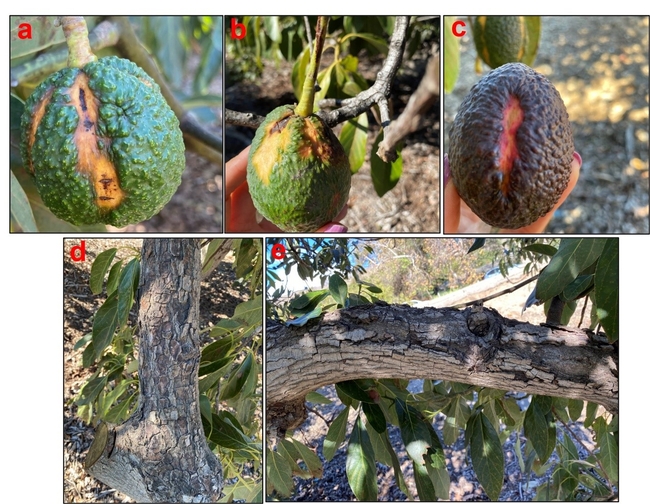Unlike other plants, avocado (Persea americana Mill.), is not a host for very many viral diseases. The occurrence of viral and viroid diseases in avocado is limited to two viroids: Avocado Sunblotch Viroid (ASBV), the smallest known viroid (246-251 nt) belonging to the Avsunviroidae and Potato Spindle Tuber Viroid (PSTV) belonging to the Pospiviroidae. The first, ASBV, only infects avocado and is economically very important and damaging to the avocado industry. While the latter has a wider range of plant hosts and is much more important for vegetables and ornamentals. ASBVd symptoms have been documented in California since the early 1900's and the name of sunblotch was given to this disease because symptoms resemble those of sunburn. Despite the first description of sunblotch in early twentieth century in California, distribution and economic impact of ASBVd on California avocado industry is not well-known yet. Currently, the disease is well-distributed in most of the avocado growing regions in the world and where it impacts yield and fruit quality. The viroid is unevenly distributed in the tree and sometimes the infected tree does not show symptoms. Symptomless trees play a significant role in the epidemiology and latent spread of the pathogen. The full impact of ASBVd is difficult to estimate because of the symptomless nature of the disease; however, researchers have documented known symptomatic and asymptomatic ‘Hass' and found up to 75% and 30% yield reduction, respectively. Additionally, ASBVd symptoms may vary under the influence of different environment, avocado cultivar, and variant of the viroid. viroid is a stable molecule which can survive outside the host cell environment for almost 7 weeks, ASBV has been documented to remain viable for 3 months in bee pollen taken from beehives.
ASBVd causes symptoms on all tree parts including fruit, leaves, branches, and twigs. While symptoms on leaves e.g., discoloration and physical distortion may rarely be seen, fruit typically show depressed/sunken scars in white, yellow, and red color which are dominantly seen at the pedicle end. Sometimes severely infected fruit show necrotic areas at the center of the crevices. Contradictory reports exist regarding the impact of ASBVd on yield, some reports state that infected trees produce abundant but small fruit in size while in some, tree yield was reported to be severely reduced. Small and misshaped fruit resulting from the viroid impact fruit marketing value. Alligator skin/bark is another typical symptom of ASBVd which is described as rectangular cracking appearance on bark of large branches and trunk of old trees. Infected trees may look stunted and old trees grow into a low and flattened shape with branches bowing toward the ground.
Future Explorations. The pace of the global avocado production is remarkedly high compared to other tropical fruits. Such increase in production is driven by high consumer demand and requires expansion of the industry and may involve the exchange of plant materials. To meet this goal, we first need to optimize reliable, sensitive, fast, and, if possible, affordable techniques to detect the pathogen. However, detection is challenging due to the uneven and irregular distribution of the viroid in avocado trees as well as the presence of asymptomatic trees.
Another interesting and challenging point that will require the attention of researchers is that some symptomatic trees spontaneously become asymptomatic and vice versa. It is assumed that stress plays a part in symptomology, but more research is needed to determine this.
Observations show that all avocado cultivars are susceptible to ASBVd but more information about the susceptibility of rootstocks and their roles in root-to-root transmission or combination of rootstock-scions is needed to be explored. Our next steps on the status of this disease will be focused on understanding the distribution and economic impacts, developing fast and reliable detection techniques with ability to detect the pathogen in any infected part of the tree, and the possible variants associated with the different symptoms. Lastly, it would be ideal if we could develop methods to control the disease.
Attached Images:
